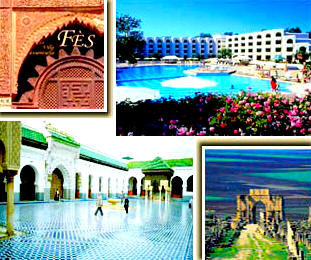 FEZ FEZ
Located between the fertile lands of the Saïs and the forests of the
Middle Atlas,
Fez is the oldest of Morocco’s imperial cities. Today
Morocco’s third largest city
and declared a World Heritage Site by
UNESCO, Fez is the embodiment of the country’s history and its
spiritual and religious capital. Its medina is believed to be the
world's largest contiguous car-free urban area.
Bou Inania & Attarine Medersa
The Bou Inania Medersa is the largest and most sumptuously decorated
medersa
ever built by the Merinids. Constructed between 1350 and
1355 by the sultan
Abou Inan, it is the only medersa in Morocco that
has a minbar (pulpit) and a minaret. A mosque, cathedral, students’
residence and school combined, its functions have determined its
architectural complexity. It is one of the few Islamic religious
buildings that is open to non-Muslims. The Attarine Medersa stands
in the neighbourhood of the Karaouine mosque and the Attarine souk.
Built between 1323 and 1325 by the Merinid sultan Abou Saïd Othman
it is, together with the Bou Inania medersa, considered to be one of
the wonders of Moorish architecture.
Karaouine Mosque
Established in 859, the Karaouine Mosque is one of the oldest and
most illustrious mosques in the western Muslim world. The first
university to be established in Morocco, it was frequented by such
learned men as Ibn Khaldoun, Ibn el-Khatib, Averroës and even Pope
Sylvester (909-1003). It is still considered to be one of the main
spiritual and intellectual centres of Islam and remains the seat of
the Muslim university of Fez.
The Tanneries
Often located near watercourses, and usually some distance from the
residential quarters because of the unpleasant odours
that they produced, tanneries made a
substantial contribution to a city’s economy. Tanning is a craft
with traditions that go back thousands of years. The process turns
animal hides into soft, rot-proof leather. Once tanned, the hides
are passed on to the leatherworkers. The Chouara, or Tanners’
Quarter, has been located near Wadi Fez since the Middle Ages. Its
dyeing vats,
in the midst of houses in the Blida
quarter, are best seen from neighbouring terraces. Although pervaded
by an unpleasantly
strong smell, this is the most lively
and picturesque of all the souks in Fez.
Mellah
Fez’ Jewish quarter owes its name ‘Mellah’ from the Arabic word for
‘salt’, the ground on which the quarter was founded and is thought
to be the first Jewish enclave to be established in Morocco.
Originally located near the Karaouine district, it was moved near
the palace by the Merinid rulers during the 13th century so they
could offer the Jewish community greater security, in return for an
annual levy. The present boundaries of the Mellah were established
only at the end of the 18th century and the restricted available
space during the time of Alaouite sultan Moulay Yazid, shows in the
striking architectural contrast with today’s Muslim quarters. The
Mellah’s visiting high lights are the Danan synagogue, the former
Jewish goldsmiths’ jewellery souk, Bab el Mellah and the Jewish
cemetery.
Bab Boujeloud
Enclosed within high walls, the large Place Pacha el Baghdadi links
the medina and Fez Jdid. On one side of the square stands Bab
Boujeloud, a monumental Moorish gate, built in 1913, and the
principal entrance into Fez el Bali. After losing its effectiveness
as defence, the fortified gates of Fez became to be seen as
decorative buildings contributing to the city’s prestige. From the
entrance way a glimpse can be caught of the minaret of the Bou
Inania Medersa.
The souks
The souks of Fez are laid out in a logical but relatively complex
labyrinth around the Karaouine mosque. Makers and sellers are
grouped together according to the products that they offer, and
every type of craft has its own street. Built by Abou Yacoub Youssef
(1286-1307) the Sidi Frijthe maristan once stood in a square near
the Henna souk. It was the largest mental asylum in the Merinid
Empire and also functioned as a hospital for storks. In the covered
streets with luxury goods shops near the Zaouia of Moulay Idriss we
find the kissaria, which marks the exact centre of the souks.
Weather:
Winter temperature = 5 - 15°C Summer temperature = 25 – 35°C
Mild, rainy winters and hot, dry summers, with a high humidity level
Festivals:
World Sacred Music Festival June
Sufi Culture Festival June
Official website of the festival:
http://www.fesfestival.com/ |